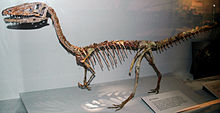
Back سيلوفايسس Arabic Cœlophysis Breton Coelophysis Catalan Coelophysis CEB Coelophysis Czech Coelophysis Danish Coelophysis German Coelophysis Spanish Coelophysis Estonian Coelophysis Basque
| Coelophysis Temporal range: Late Triassic (middle to late Norian),
| |
|---|---|

| |
| Mounted skeleton at the Cleveland Museum of Natural History | |
| Scientific classification | |
| Domain: | Eukaryota |
| Kingdom: | Animalia |
| Phylum: | Chordata |
| Clade: | Dinosauria |
| Clade: | Saurischia |
| Clade: | Theropoda |
| Family: | †Coelophysidae |
| Genus: | †Coelophysis Cope, 1889c |
| Type species | |
| †Coelurus bauri Cope, 1887a
| |
| Species | |
| |
| Synonyms | |
|
Genus synonymy
Synonyms of C. bauri
Dubious species designations
| |
Coelophysis (/sɛˈlɒfɪsɪs/ se-lOF-iss-iss traditionally; /ˌsɛloʊˈfaɪsɪs/ SEL-oh-FY-siss or /ˌsiːloʊˈfaɪsɪs/ SEE-loh-FY-siss, as heard more commonly in recent decades[3]) is a genus of coelophysid theropod dinosaur that lived approximately 215 to 208.5 million years ago during the Late Triassic period from the middle to late Norian age in what is now the southwestern United States.[4][5] Megapnosaurus was once considered to be a species within this genus,[6] but this interpretation has been challenged since 2017 and the genus Megapnosaurus is now considered valid.[7][5][8][9][10]
Coelophysis was a small, slenderly built, ground-dwelling, bipedal carnivore that could grow up to 3 m (9.8 ft) long. It is one of the earliest known dinosaur genera. Scattered material representing similar animals has been found worldwide in some Late Triassic and Early Jurassic formations.
The type species C. bauri, originally given to the genus Coelurus by Edward Drinker Cope in 1887, was described by the latter in 1889. The names Longosaurus and Rioarribasaurus are synonymous with Coelophysis. Coelophysis is one of the most specimen-rich dinosaur genera.
- ^ Cite error: The named reference
bristowe2004was invoked but never defined (see the help page). - ^ a b Carrano, Matthew T.; Benson, Roger B. J.; Sampson, Scott D. (2012). "The phylogeny of Tetanurae (Dinosauria: Theropoda)". Journal of Systematic Palaeontology. 10 (2): 211–300. doi:10.1080/14772019.2011.630927. S2CID 85354215.
- ^ "RE: Afrovenator pronunciation". dml.cmnh.org. Archived from the original on 24 February 2012. Retrieved 26 May 2019.
- ^ Irmis, Randall B.; Mundil, Roland; Martz, Jeffrey W.; Parker, William G. (15 September 2011). "High-resolution U–Pb ages from the Upper Triassic Chinle Formation (New Mexico, USA) support a diachronous rise of dinosaurs". Earth and Planetary Science Letters. 309 (3–4): 258–267. Bibcode:2011E&PSL.309..258I. doi:10.1016/j.epsl.2011.07.015.
- ^ a b Martínez, R.N.; Apaldetti, C. (2017). "A Late Norian—Rhaetian Coelophysid Neotheropod (Dinosauria, Saurischia) from the Quebrada Del Barro Formation, Northwestern Argentina". Ameghiniana. 54 (5): 488–505. doi:10.5710/AMGH.09.04.2017.3065. hdl:11336/65519. S2CID 133341745.
- ^ Weishampel, David B; et al. (2004). "Dinosaur distribution (Early Jurassic, Africa)." In: Weishampel, David B.; Dodson, Peter; and Osmólska, Halszka (eds.): The Dinosauria, 2nd, Berkeley: University of California Press. Pp. 535–536. ISBN 0-520-24209-2
- ^ Spiekman, S.N.; Ezcurra, M.D.; Butler, R.J.; Fraser, N.C.; Maidment, S.C. (2021). "Pendraig milnerae, a new small-sized coelophysoid theropod from the Late Triassic of Wales". Royal Society Open Science. 8 (10): 210915. Bibcode:2021RSOS....810915S. doi:10.1098/rsos.210915. PMC 8493203. PMID 34754500.
- ^ Barta, D.E.; Nesbitt, S.J.; Norell, M.A. (2018). "The evolution of the manus of early theropod dinosaurs is characterized by high inter‐and intraspecific variation". Journal of Anatomy. 232 (1): 80–104. doi:10.1111/joa.12719. PMC 5735062. PMID 29114853.
- ^ Tolchard, F.; Nesbitt, S.J.; Desojo, J.B.; Viglietti, P.; Butler, R.J.; Choiniere, J.N. (2019). "'Rauisuchian' material from the lower Elliot Formation of South Africa and Lesotho: Implications for Late Triassic biogeography and biostratigraphy". Journal of African Earth Sciences. 160: 103610. Bibcode:2019JAfES.16003610T. doi:10.1016/j.jafrearsci.2019.103610. S2CID 202902771.
- ^ Ezcurra, Martín D; Butler, Richard J; Maidment, Susannah C R; Sansom, Ivan J; Meade, Luke E; Radley, Jonathan D (1 January 2021). "A revision of the early neotheropod genus Sarcosaurus from the Early Jurassic (Hettangian–Sinemurian) of central England". Zoological Journal of the Linnean Society. 191 (1): 113–149. doi:10.1093/zoolinnean/zlaa054. hdl:11336/160038. ISSN 0024-4082.